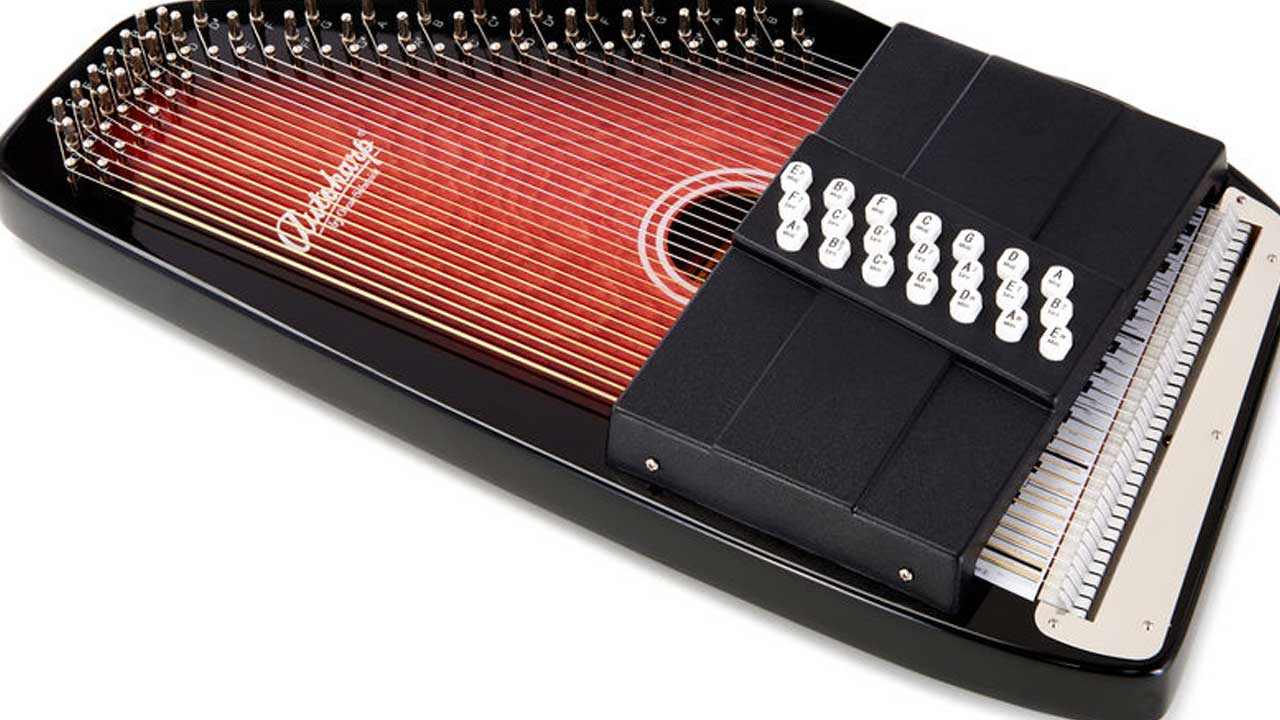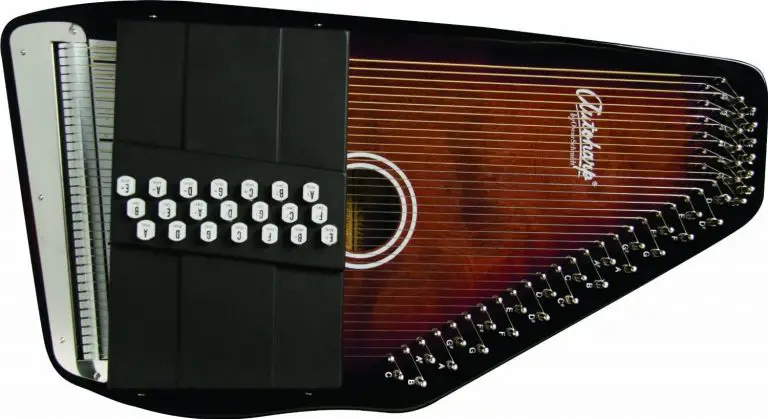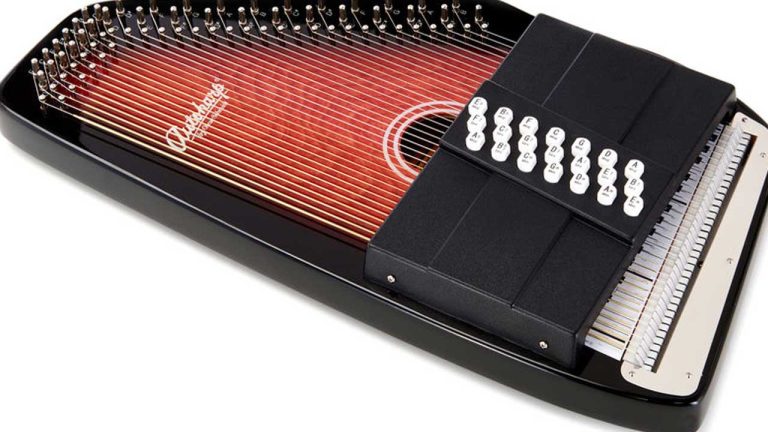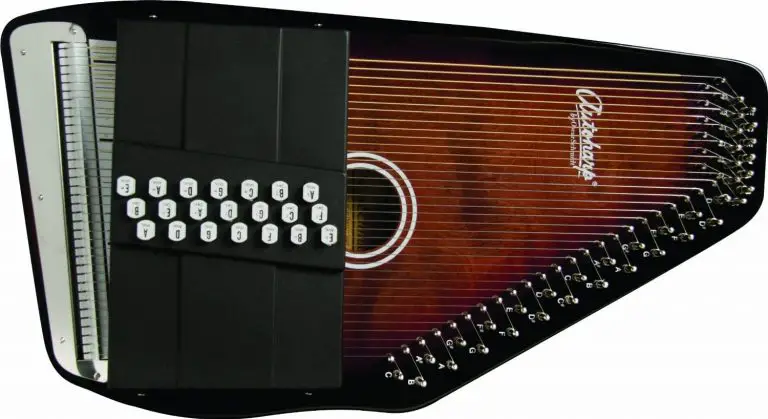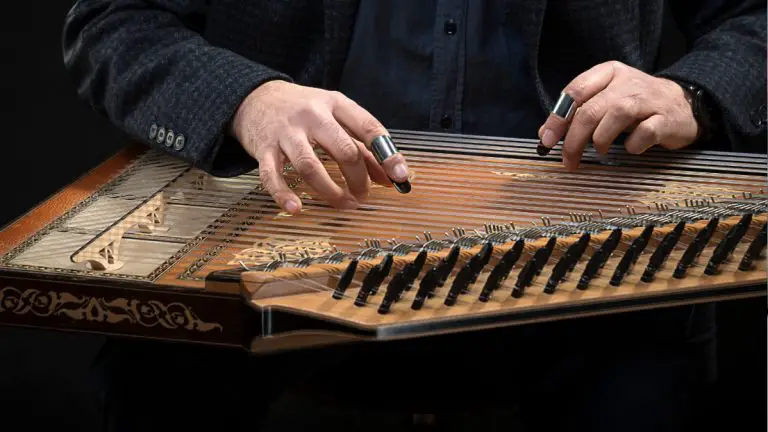Autoharp vs Harpsichord: Comparing Stringed Classics
Folkstrings.com is reader-supported. When you buy through links on our site, we may earn a small commission.
The autoharp and harpsichord are both fascinating string instruments with rich histories.
My interest in these instruments stems from their unique sounds and the different contexts in which they are used.
The autoharp, with its chords played by pushing buttons, offers a simplicity that belies its delightful complexity of sound.
This portable instrument is often associated with folk music and education, having a place in both the classroom and on the concert stage.
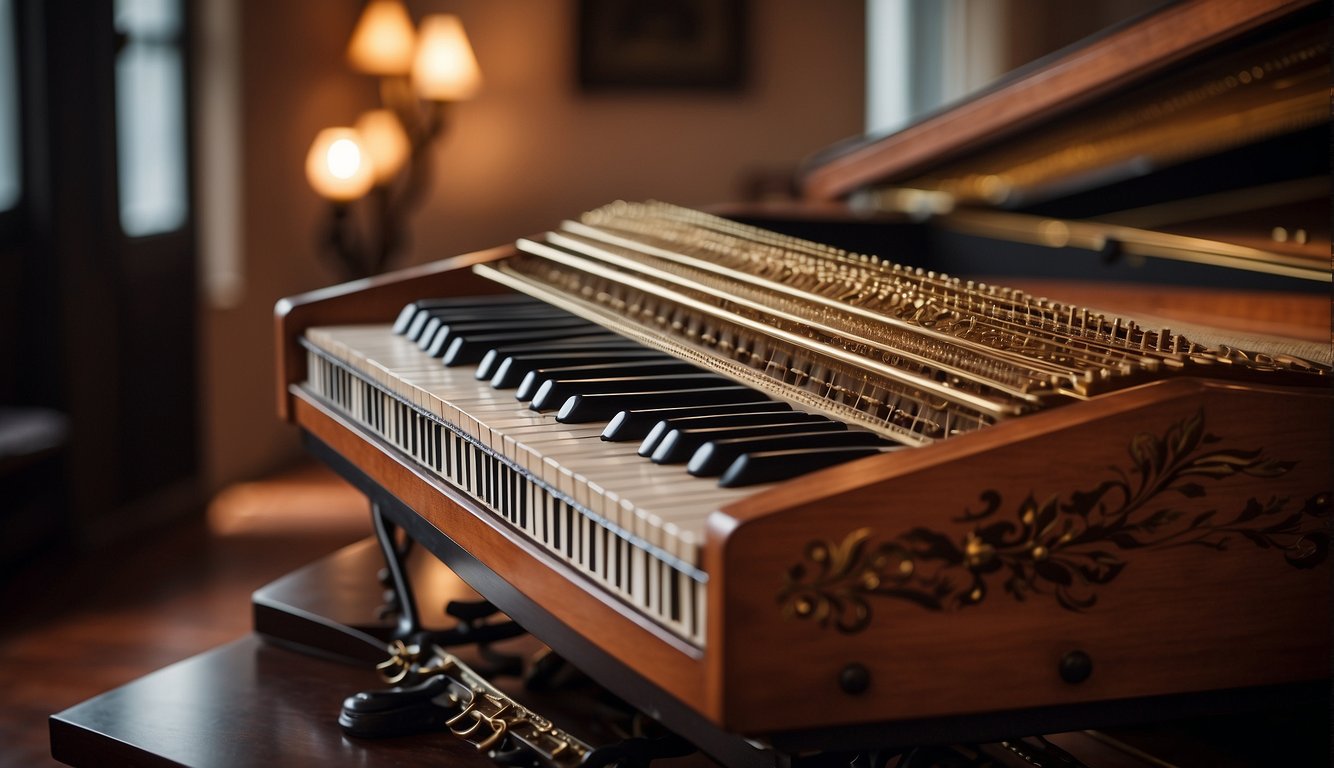
In contrast, the harpsichord, recognizable by its lavish design and distinctive plucked string sound, hails from an earlier period and has a strong association with Baroque music.
Unlike the autoharp, the harpsichord is played using a keyboard, which mechanically plucks the strings. Its ornate construction is not just about visual appeal but also contributes to its complex tonal qualities.
Both instruments reflect the eras from which they came, capturing the musical essence of their respective times.
Key Points
- The autoharp features a simple design with a rich sound, often used in folk music.
- The harpsichord’s plucked strings and elaborate design have made it synonymous with Baroque music.
- Each instrument reflects its historical era and has evolved in construction and techniques over time.
Table of Contents
Origins and Historical Development
As we dive into the rich past of the autoharp and harpsichord, you’ll discover fascinating stories that illustrate their unique contributions to musical history.
Autoharp Origins
The autoharp, with its simple yet beautiful sound, is actually a fairly recent invention compared to other string instruments.
Oscar Schmidt, a German immigrant to the United States, is often associated with the autoharp, although he was not the original inventor. The true credit goes to Charles F. Zimmermann, who patented the autoharp in 1882.
Zimmermann, a music teacher and instrument enthusiast from Philadelphia, invented the autoharp. Later, a fellow German, Karl August Gütter, improved the design to what we recognize today.
- Inventor: Charles F. Zimmermann
- Patent: 1882
- Improvements by: Karl August Gütter
Harpsichord Evolution
The harpsichord is a musical treasure from the Renaissance and Baroque eras, predating the piano.
Known for its plucked string sound, the harpsichord’s origins can be traced back to the 14th century. It evolved significantly throughout the centuries, reaching its peak of popularity and development during the late Renaissance into the Baroque period.
This instrument was a staple in European music, flourishing in Italy, France, and Germany, and it’s distinct for its elaborate and ornate style.
- Origin Period: 14th century
- Popularity Peak: Renaissance to Baroque era
- Notable Regions: Italy, France, Germany
Design and Construction
In my exploration of musical instruments, I’ve come to appreciate the nuances in design and construction that make each one unique. Let’s look at how the autoharp and harpsichord stand apart in their build.
Autoharp Anatomy
My experience with the autoharp reveals its straightforward yet elegant design. The body is primarily wood, offering both visual appeal and acoustic resonance.
At its heart, the soundboard plays a pivotal role in sound production, with vibrations resonating through the wood to create the instrument’s signature tone.
The autoharp’s strings are typically made of steel and vary in gauge to produce a range of pitches.
Above the strings, the chord bars, covered with felt pads, selectively dampen strings to form chords with a press of the chord buttons.
My autoharp’s tuning is achieved through a series of tuning pins, which I turn to tighten or loosen the strings, altering the pitch. Metal plates may reinforce the frame, adding to its durability.
Key Features:
- Frame: Wood, typically spruce or maple.
- Strings: Steel, varying in number generally around 36.
- Size: Compact and portable.
- Chord Bars: Often outfitted with 21 to 36 chord bars.
- Finish: Natural wood or laminated.
Harpsichord Structure
I find the harpsichord to be a more complex construction. Its body is also made of wood, but with an intricate inner mechanism.
The soundboard in a harpsichord plays a similar role as in the autoharp but is mounted within a larger frame that supports a significant string tension.
In my harpsichord, the strings are made of varying materials, ranging from brass to steel, and they’re plucked by quills or plectra attached to a jack mechanism, rather than struck. The keyboard operates these jacks.
The instrument’s tuning involves adjusting these strings, which span over a soundboard to produce a dynamic range of notes.
Harpsichordists like myself can play on one or two manuals (keyboards), extending the range and complexity of music that can be performed.
Key Features:
- Soundboard: Wood, including spruce or cypress for riches.
- Strings: Brass or steel, in sets called choirs.
- Range: Typically five octaves.
- Keyboard: One or two sets of keys.
- Frame and Size: Larger and less portable than an autoharp, with a sophisticated casing often featuring intricate wood inlays or paintings.
- Metal Plate: None, unlike some autoharps.
Playing Technique and Sound
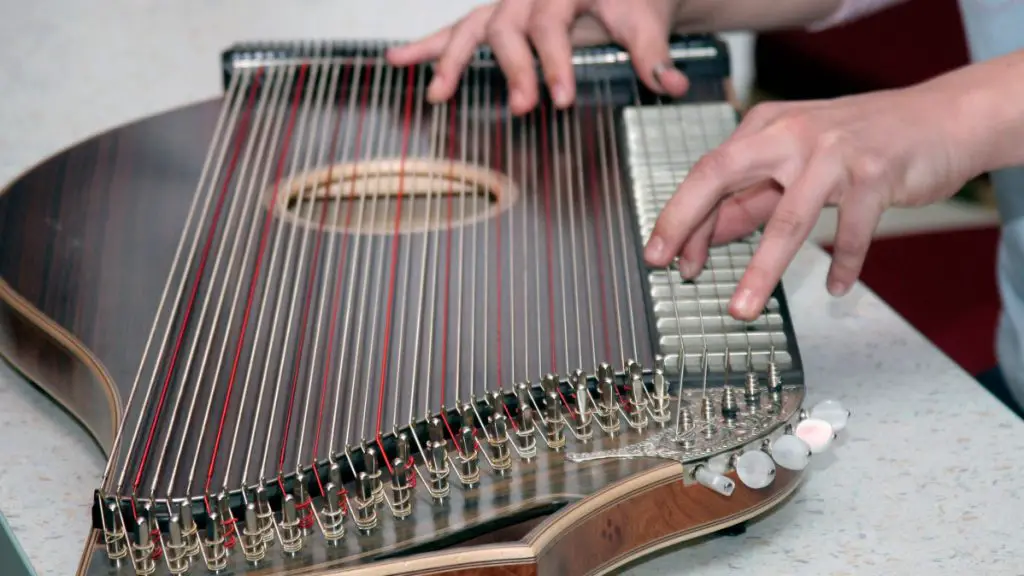
As we explore the playing technique and sound of autoharps and harpsichords, we’ll see how these instruments require distinct approaches to master their distinctive sonorities. Both demand a unique set of skills to bring out their rich textures and nuanced tones.
Mastering the Autoharp
The autoharp charms with its simplicity. I find that it is often played by strumming or plucking the strings with fingers or a plectrum.
This instrument typically features a series of chord bars outfitted with dampers, which allow me to select chords with ease. By pressing a chord bar, I can mute all the strings that do not form part of the chord, enabling me to play major, minor, and dominant seventh chords with a crisp, clear sound.
- Chord Bars: Mute unrelated strings for clean sound
- Strumming or Plucking: Create rhythm or melody
- Chords: Major, minor, and dominant seventh achievable
Harpsichord Performance
In contrast, the harpsichord requires a more refined touch. Unlike the autoharp, I engage with this instrument through a keyboard.
When I press a key, a plectrum plucks the string, resulting in a precise and somewhat metallic sound. Harpsichords don’t allow for dynamic variation in volume — each note resonates at a consistent intensity.
I must rely on finger technique and articulation to convey emotion and musical expression. Additionally, I use different stops or registers in the harpsichord to change the sound quality, adding layers of complexity to the performance.
- Keyboard Technique: Finger precision for articulate performance
- Plectrum Mechanism: Strings are plucked for distinctive sound
- Stops or Registers: Alter the timbre and texture of the music
Variations and Modern Adaptations
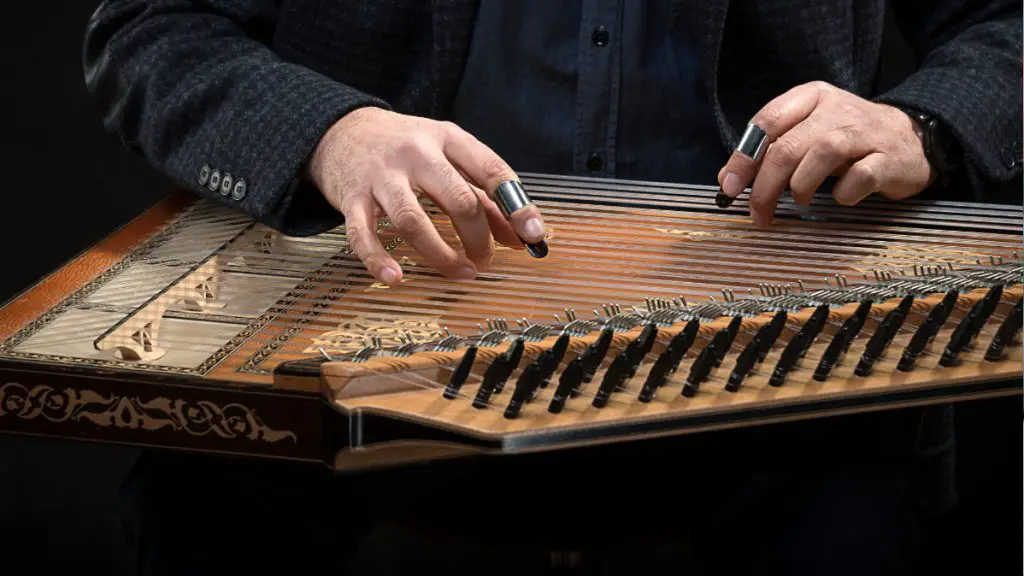
In exploring the landscape of autoharps and harpsichords, I’ve noticed a fascinating evolution of these instruments through variations and modern adaptations that cater to different musical styles and player preferences.
Different Types of Autoharps
The autoharp has witnessed a variety of models, including the chromaharp and the electric autoharp. Each brings its own flavor to the world of music.
Type A and Type B chromaharps are relatively common, with Type A featuring a chromatic button arrangement that allows for a wide range of keys and chords. In comparison, the Type B models lean more towards diatonic playing, suited for folk music.
The electric autoharp adds an amplification aspect, enhancing its presence in modern Americana and contemporary genres.
I’ve also encountered the OS73 model, a re-imagining of the autoharp that echoes the sounds of the Carter Family, pioneers in integrating the instrument into American folk music.
Another variant, somewhat similar to the autoharp, is the volkszither, a plucked string instrument from the zither family that offers a slightly different sonic texture and has its own place in the tapestry of folk instruments.
Harpsichord in Today’s Music
Harpsichords, traditionally known for their distinctive place in classical music, are now finding their way into modern compositions.
The electric harpsichord, for example, provides an intriguing blend of the old and new, giving the classical sounds a fresh twist. This isn’t your typical harpsichord; the electric version can have adjustable tone settings thanks to added springs and modern technology.
Today’s players and composers utilize the harpsichord’s unique timbral quality, integrating it into genres far beyond its Baroque roots, fostering its continuity into the 21st century.
In both the autoharp and harpsichord realms, these adaptations show how historic instruments can evolve to stay relevant and beloved in today’s diverse musical landscape.
Frequently Asked Questions
In this section, I’ll address some common curiosities regarding the distinctions between autoharps and harpsichords.
I’ll explore their sounds, playability, usage in music, historical context, mechanisms, and note ranges.
What are the main differences in sound between an autoharp and a harpsichord?
The autoharp emits a warm, resonant tone due to its strummed or plucked strings with a felt damper system, whereas the harpsichord produces a brighter, more metallic sound as its strings are plucked by quills or plectrums.
How do autoharps and harpsichords compare in terms of playability for beginners?
Autoharps are often seen as more accessible for beginners due to their simple button-press chord playing method.
In contrast, the harpsichords require users to navigate a keyboard and possess a more complex technique for dynamic expression.
In what types of music are autoharps commonly used versus harpsichords?
Autoharps are frequently found in folk, country, and bluegrass music, while harpsichords have a strong presence in Baroque, Renaissance, and classical music compositions.
What are the historical backgrounds of the autoharp and harpsichord?
The autoharp is relatively modern, emerging in the late 19th century, while the harpsichord boasts a longer history.
It dates back to the late Medieval period with peak usage during the Renaissance and Baroque periods.
How does the autoharp’s mechanism differ from that of the harpsichord?
An autoharp’s mechanism involves a series of bars that, when pressed, dampen all strings except those that form the desired chord.
In contrast, a harpsichord’s mechanism requires keys to be pressed, activating a jack that plucks individual strings.
Can an autoharp achieve a similar range of notes as a harpsichord?
While both instruments can cover wide note ranges, a harpsichord typically has a broader range.
This range spans several octaves, akin to a piano. On the other hand, an autoharp typically has a more limited note range. This is due to its fixed string and chord configuration.
Author Profile
-
Daniel Johnstone is an English writer with a love for stringed instruments from around the world.
He shares his love for these instruments through his writing for folkstrings.com, a website dedicated to all things related to folk string music.
Daniel's passion for music started at a young age, and he has since become an accomplished musician, playing guitar, cavaco, and recently, the harp.
His dedication to learning and sharing his knowledge of stringed instruments is evident in his insightful and engaging blog posts. Whether you're a seasoned musician or a beginner, Daniel's writing is sure to inspire and entertain you.
When he's not playing music or writing, you can find Daniel exploring new instruments and seeking out new sounds to share with his readers.
Latest entries
 AutoharpApril 4, 2024What Is the Autoharp Made Of: Exploring Its Materials and Craftsmanship
AutoharpApril 4, 2024What Is the Autoharp Made Of: Exploring Its Materials and Craftsmanship AutoharpApril 4, 2024Is Autoharp Easy to Play? Unveiling the Truth for Beginners
AutoharpApril 4, 2024Is Autoharp Easy to Play? Unveiling the Truth for Beginners AutoharpApril 4, 2024What Is an Autoharp Worth? Your Guide to Pricing and Value
AutoharpApril 4, 2024What Is an Autoharp Worth? Your Guide to Pricing and Value AutoharpApril 4, 2024Are Autoharp and Zither the Same Thing? Unraveling String Instrument Myths
AutoharpApril 4, 2024Are Autoharp and Zither the Same Thing? Unraveling String Instrument Myths
Affiliates:
This post may contain affiliate links that at no additional cost to you, the site may earn a small commission. We only recommend products we would use ourselves and all opinions expressed on this site are our own.
Accuracy Advice:
While we strive to provide up-to-date and accurate information, the content in this article may not reflect the most current research or medical guidelines. We encourage readers to do further research and consult with professionals for more personalized advice.
Our Recommendations:
The products and services mentioned in any of our articles are recommended based on our independent research and personal experience. We are not sponsored by any company. We aim to suggest products and services we believe are of high quality and could be beneficial to our readers.

